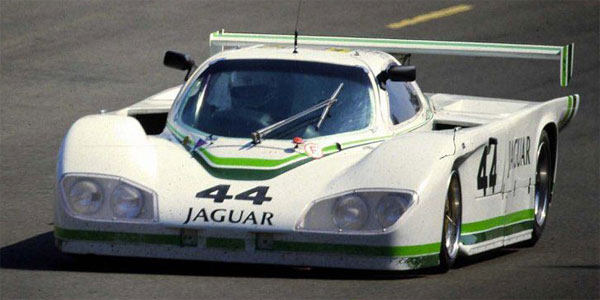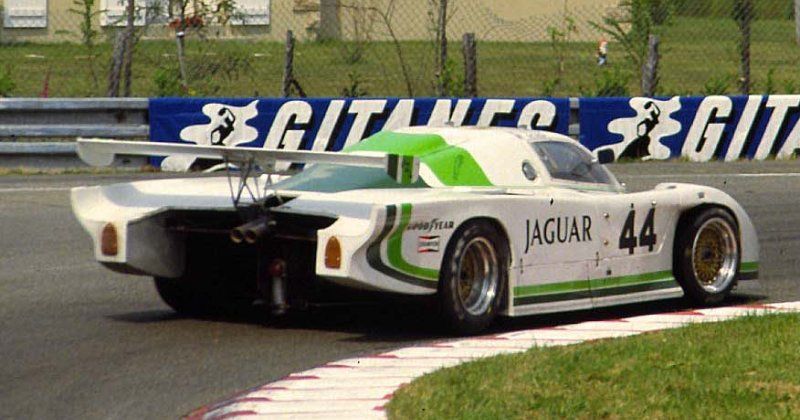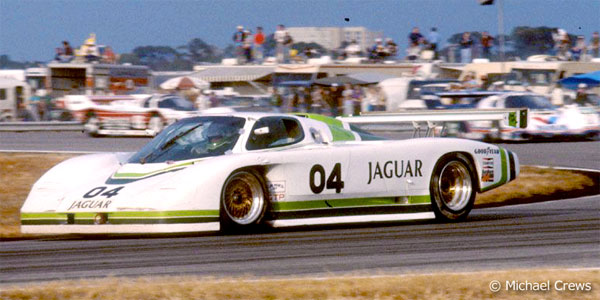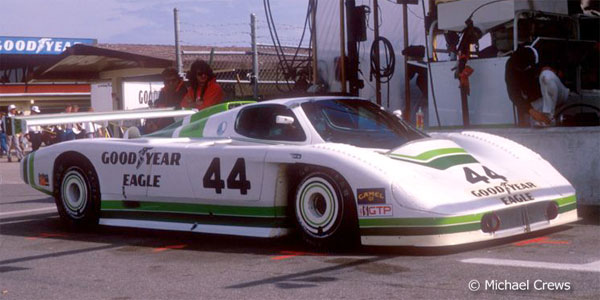|
|
32375 view(s)  1983 Group 44 1983 Group 44
Bob Tullius was a racer. When he took on racing, he drove many types of cars, from Dodge Darts to Ford Mustangs, then Jaguar Es, XJS, Triumph TR8s and later, Jaguar XJR5s and 7s. He had a British Leyland dealership and when he took part of the American GTP series, his goal was to improve the Jaguar image.
The goal assigned to the team was clear : they wanted to improve their image. So it was decided to launch a new prototype that would be called the XJR5. Bob Tullius had commissioned Lee Dyjkstra to build the car. He had achieved many glorious cars, including the Dekon Chevrolet Monza, the CRC Can Am car. Everything had to use authentic Jaguar parts and they had to use the V12 5,3L engine. The car had to be legal for GTP and Group C Racing.
The car was sleek and used the usual V12 engine, given for 530hp. The very first race was to be at Road America, where Bob Tullius and Bill Adam ran a very conservative race to finish third overall. For this very first event, the team could see the new GTP car appeal to the marshals as they clapped their hands while watching the new car running for the first time. The remainder of the season proved to be much more difficult to handle for the team as a succession of woes occured.
The car experienced a practice accident at Mid Ohio and was forced into the wall at the Daytona Finale. The drivers and the team had to learn how to develop the car and it took a lot of time to apprehend it. The 1983 season would be hard in the beginning, yet success was to come by quickly.
They failed to finish the two first enduros of the season, but at Road Atlanta, Bob Tullius and Bill Adam survived typically wet conditions to record their first win. It was the first major win for the marque since long. Then the car won at Lime Rock. The car won its first pole position at Portland but had to retire from the race after Bill Adam collided with Jim Mullen's car in the race. The car now was able to be fast on the track, while reliable. The team won again at Mosport but, later, Bill Adam would be fired from the team. Bob Tullius had replaced him by Doc Bundy, hoping things would improve with time. The new Bob Tullius-Doc Bundy pair won at Pocono their fourth race of the season. At the end of the season, Bob Tullius was second in points, to Al Holbert, winning in his March 83G Porsche.
1984 Defending Jaguar's colors in France
 For 1984, the team lost the Quaker State sponsorship. After considering any collaboration with the team, Miller Brewing Company, with its Löwenbräu brand, decided not to go further with Group 44, so the 1984 season began with no sponsor but Jaguar. For 1984, the team lost the Quaker State sponsorship. After considering any collaboration with the team, Miller Brewing Company, with its Löwenbräu brand, decided not to go further with Group 44, so the 1984 season began with no sponsor but Jaguar.
The Daytona 24 Hour race began with a retirement, after leading the race for more than a hundred laps. Bob Tullius-Doc Bundy and David Hobbs were rewarded with a third overall. Two cars were entered for most of the season for Bob Tullius-Doc Bundy and Brian Redman-Hurley Haywood. The main success for the team was a one-two at Miami with Brian Redman-Hurley Haywood taking victory over Bob Tullius and Doc Bundy. The team took a third at Road Atlanta and second and third on the high banks of Charlotte Motor Speedway. A third at Watkins Glen and a second at Portland, a second and third at Sears Point and a second at Pocono was not so bad for the team who had however great hopes but ended up the season quite disappointed.
It was decided to send the cars to Le Mans, for the famous 24 Hour race. It was a real challenge, and some kind of nightmare for the team, who was not prepared for such a trip. After qualifying on row seven and ten. They managed to take the lead of the race, thanks to their superior fuel mileage. Unfortunately, the two cars had to retire later in the race. Despite this failure, the race was a relative success for Jaguar.
1985 Disaster at Daytona
The team had had some transmission failures and it was decided during the winter to replace the original gearbox by a new Hewland. Now designated XJR5B because of the numerous changes, the 1985 season began with a terrible accident at Daytona when Bob Tullius hit the wall after a failed tyre severed oil lines, sending him into the wall. Trapped in his car for more than forty minutes, Bob Tullius had his hands badly burned. He recovered quite fast and drove three weeks later at Miami. 
Chip Robinson had been signed as Bob's new co-driver, and they would finish second at Road Atlanta, while Brian Redman and Hurley Haywood took the win in the number 04 car. While confident with his cars, Bob Tullius felt that was missing to them was a turbocharger. He asked Jaguar if he could use the Metro 6R4 engine, but Jaguar declined.
The next races were rewarding seconds at Laguna Seca, Charlotte and Lime Rock, and the Le Mans experience was renewed. They felt confident and had been warmly welcomed, this time bringing their own radios. Qualifying sixteenth and seventeenth, the cars had suffered pistons in practice. Realizing after the race that they had been awarded a bad batch of fuel by the organizers' fuel supplier, they had detuned their engines for the race.
For the race, things went mildly better with car number 44 finishing thirteenth after a cylinder dropped ninety minutes short of the chequered flag. Bob Tullius was rewarded with the cheers of the crowd while passing the stands. Back to US, the team had a string of seconds and thirds, but no win.
It was time for the team to develop a brand new car, the XJR7, which was entirely new, except for the windshield.  The car was debuted at the Daytona Finale, for Bob Tullius and Chip Robinson. The car was debuted at the Daytona Finale, for Bob Tullius and Chip Robinson.
The XJR5 took a second place with Hurley Haywood and Brian Redman, while Bob Tullius and Chip Robinson finished fourth after an early incident with the wall.
1986 XJR 7 The last American Jag
The 1986 season began at Daytona with two XJR7s running. The two cars experienced gearbox problems caused by drivetrain overload from the chassis. The number 44 car, driven by Bob Tullius, Chip Robinson and Claude Ballot Léna, finished sixth overall. A new gearbox was installed for the Sebring race, but neither car finished the race. Lee Dykstra and Bob Tullius had ceased their relationship prior to the race. In fact, Jaguar wanted to hire him, which they did, so Bob Tullius had to fire him.
Things changed a lot after Lee Dykstra's departure, and the relationship between Bob Tullius and Jaguar worsened. The race held at Riverside was reminded for everyone as one of the most spectacular crashes ever. Chip Robinson collided with Doc Bundy and Lyn St James on lap thirty six, resulting in the Jaguar flying up in the air. Fortunately, neither driver was hurt but the three cars were completely written off. This major incident resulted in Group 44 entering only one car for the next round at Laguna Seca. The third chassis had been damaged in a practice session. Hurley Haywood was partnered by Chip Robinson and they finished second to Klaus Ludwig, who gave the Ford Probe its first win. The remainder of the season was a succession of dnfs, mainly caused by crankshafts. They had to revert to older parts and had a third place finish at Columbus for Brian Redman and Hurley Haywood.
The end of the season had a special taste, because Chip Robinson and Brian Redman were leaving the team. The team scored its only victory at the Daytona Finale with Bob Tullius and Chip Robinson while Brian Redman and Hurley Haywood had a dnf, with an engine failure. The 1987 season began at Daytona with a dnf for the sole Jaguar XJR7 entered, due to overheating. The car had run as high as second during the race. The next race, held at Miami, rewarded an ignominous tenth to Hurley Haywood and John Morton, while Nissan scored its first IMSA victory. The next race was a great success for the team : Hurley Haywood and John Morton won the Riverside race over Al Holbert and Chip Robinson by a 2.78 second margin.
Things were getting tight between Group 44 and Jaguar. The team felt that they lacked support from the British marque. Yet, for the season to come, Jaguar had chosen Tom Walkinshaw to run their IMSA cars and then it was over. The team entered the West Palm Beach race, and it would be the very last IMSA win for Group 44. John Morton and Hurley Haywood won over the Al Holbert Porsche 962. The last official race for the team was held at Watkins Glen, where Bob Tullius and John Morton finished thirteenth. From Bob Tullius point of view, things were sealed from the beginning. They entered the last race of the season at Del Mar, but not under the Group 44 banner. The team was entered in a single event in 1988, Without an "official" link to Jaguar, the car was dubbed "Group 44 V12". Eventhough it was now propelled by a Chevy V8.

The very last GTP race for the Group 44 Team was the 1988 Daytona 24hrs. Bob Tullius, John Morton and Whitney Ganz had a very disappointing race ritiring the Group 44 V12 at 7.55PM, due to overheating.
The team signed to run Audi Quattros in the Trans Am series, and they earned the title with Hurley Haywood driving. Hans Stuck and Walter Rohrl were part of that dream-team. However, Bob Tullius had still GTP hopes, and had a car built by Randy Wittine. It was based on the last XJR7 chassis and was powered by a Chevrolet engine. He had in mind several chassis that he wanted to sell as customer cars. But the project did not arouse sufficient interest to build a second car. The story of Group 44 in IMSA was over, and it was as if Group 44 had never existed. When speaking about Jaguar history, Group 44 is never quoted as a great team, and very few people think of them as Jaguar spearhead.
Yet, they must be credited with many wins, and they have brought back Jaguar to their first international wins. The Jaguar XJS, Triumph TR8, Jaguar XJR5 and XJR7 have succeeded in many races, and the Group 44 team has achieved some great successes.
However, the team has always been underestimated, and it is a shame for every Jaguar or Triumph lover. The Group 44 team remains one of the most successful team in SCCA and IMSA racing. They deserve a better recognition from everyone.
Text by: Alexis Gousseau IMSA Blog: History of IMSA racing
|
Models for Jaguar XJR 5
 |
| Manufacturer |
Model |
Scale |
Dimensions (LxWxH) |
Wheelbase |
Front spur |
Rear spur |
| Profil 24 |
Group 44 LM 1985 |
1/24 |
0.0x0.0x0.0 |
0.0 |
0.0 |
0.0 |
| Profil 24 |
Group 44 LM 1984 |
1/24 |
0.0x0.0x0.0 |
0.0 |
0.0 |
0.0 |
|

